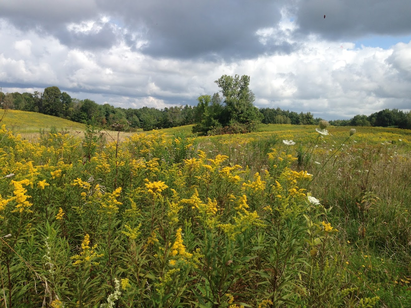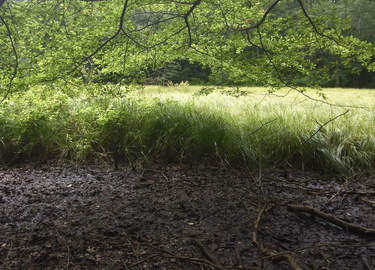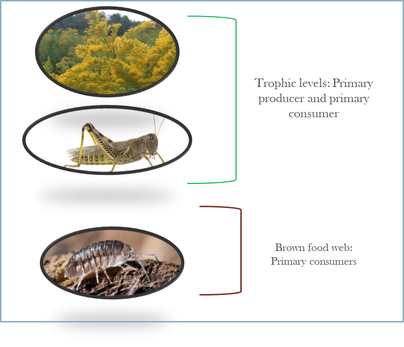 A old field of goldenrod, asters and Queens Anne’s Lace in Winooski, VT. A old field of goldenrod, asters and Queens Anne’s Lace in Winooski, VT. Written by: Zac Lamas and Graham Stewart If you are traveling in New England and have ever passed an open meadow that isn’t being used for agriculture, you’re probably looking at an “old field” ecosystem. These are dense fields filled with a variety of flora- typically dominated by the early summer legumes trefoil and trillium, followed by the late season goldenrods and asters. While these fields are often overgrown, occasional mowing or controlled burning prevents succession to a forested state. These old field ecosystems provide rich models for studying nutrient cycling. Rob Buchkowski, a PhD candidate from Yale, has spent his dissertation investigating “brown” (traditionally thought of as belowground) and “green” (traditionally thought of as aboveground) food webs, and how nutrition flows through and between these components of old field ecosystems. If you’re up for a bit of a ride, we’ll follow Rob through a bird’s eye view of the major principles of food chains, how nutrition moves through the system, and how we can mathematically model these systems  Above- and below-ground food webs are inextricably linked. Above- and below-ground food webs are inextricably linked. Brown and Green Primary producers represent the bulk of the green food web. In forests, for example, these are largely trees, understory vegetation, and ferns and other small plants. Primary consumers feed on primary producers, and the secondary consumers who in turn feed on them are part of the green food web. But the flow of nutrients neither starts nor stops here. The brown food web represents much of the life forms, and metabolic activity, on earth. The brown food web consists of anything that breaks down organic matter, and is largely made up of fungi, bacteria and soil fauna (e.g. earthworms and pill bugs). Everything produced is eventually broken down, and this is what provides the energy and nutrients for new production. Rob Buchkowski uses old field ecosystems in New England to ask questions about nutrient cycling within and between green and brown food webs. In particular, Rob is interested in how components of both food webs drive plant community composition. Rob focuses on three of the major players involved in these systems: grasshoppers and soil isopods and earthworms. To investigate their respective roles in nutrient cycling, Rob created different factorial test plots that excluded various combinations of the two organisms, and then tracked how nitrogen moved through the system.  A visual diagram of the major players in Rob Buchkowski’s work: goldenrod and grasshoppers represent primary producers and consumers in the green food web. Soil isopods represent major players in the brown or detritus food web. A visual diagram of the major players in Rob Buchkowski’s work: goldenrod and grasshoppers represent primary producers and consumers in the green food web. Soil isopods represent major players in the brown or detritus food web. One major take-away from Rob’s work is that changes in green and brown food chains likely need to persist past a threshold length of time to have notable impacts on ecosystems. We wouldn’t expect the plant community composition, one focus of Rob’s study, to change suddenly because of an influx in either grasshoppers or soil isopods. However, through additive effects, plant compositional change could occur through permanent changes in soil characteristics or nitrogen cycling. In plots with high herbivory, Rob observed an increase in plant nitrogen content, which can then be passed on to organisms in the brown food web. Thus, the grasshopper herbivory ultimately provided more nutrition to the earthworms and pill bugs. In summary, Rob’s work showed that herbivores change leaf litter by consuming plants, and that litter properties change nitrogen recycling back to the plants. Conversely, what happens when a decomposer changes the nutritional composition of soil? During his field trials, Rob found 3-5 earthworm species, all of which are common in New England and are responsible for much of the decomposition by this group of organisms. However, if a non-native earthworm were to invade, would its feeding behavior affect nitrogen cycling through the brown ecosystem? We don’t exactly know what happens to all the nitrogen that enters the soil. Some is stored or becomes otherwise inaccessible to aboveground organisms, and the rate that nitrogen becomes available depends on both biotic and abiotic processes. It is possible that a new invasive earthworm could trigger nitrogen to cycle at a much faster rate than it did previously, which could ultimately change the composition of the green food web. Let’s return to our original question, What drives plant community composition? Can the simple feeding habits of a grasshopper have a profound enough effect to change the composition of other organisms farther away in the same food chain? Or can a change in the brown ecosystem completely alter the composition of green food web? The answer is not clear. It is possible that over a long period of time the additive effects of plant herbivory or soil isopods could shift soil characteristics enough to cause a change in the composition of the plant community. However, according to Rob, the additive effects of these changes could take decades to play out, while his own work is focused on short-term changes. What you may very well see as you pass that slightly overgrown field, filled with goldenrod and asters, is a snapshot in time. The plant composition of this system will likely change, not quickly via the feeding habits of a grasshopper, but from the additive effects of many years, of many interactions, one on top of the other. About the authors Zachary Lamas, PhD student, vanEngelsdorp Lab Graham Stewart, MS student, Palmer Lab Comments are closed.
|
Categories
All
Archives
June 2024
|
Department of Entomology
University of Maryland
4112 Plant Sciences Building
College Park, MD 20742-4454
USA
Telephone: 301.405.3911
Fax: 301.314.9290
University of Maryland
4112 Plant Sciences Building
College Park, MD 20742-4454
USA
Telephone: 301.405.3911
Fax: 301.314.9290

 RSS Feed
RSS Feed




